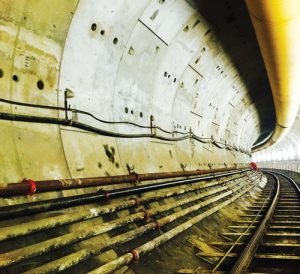 The underwater tunnel below the bed of Hooghly River connect two iconic Indian Railways stations – Howrah Junction and Sealdah which is a result of precise planning and meticulous execution. The twin tunnels were built in just 67 days while the budgeted time for tunnelling the 2.9km stretch was 127 days. Once operational, the service will revolutionise travel in Kolkata.
The underwater tunnel below the bed of Hooghly River connect two iconic Indian Railways stations – Howrah Junction and Sealdah which is a result of precise planning and meticulous execution. The twin tunnels were built in just 67 days while the budgeted time for tunnelling the 2.9km stretch was 127 days. Once operational, the service will revolutionise travel in Kolkata.
Underwater tunnelling has been done across the world, and with considerable success. IIndia will soon get its first underwater metro rail tunnel by 2021! Kolkata Metro- India’s oldest metro rail network, will soon have an European-style underwater tunnel as part of its East-West Metro project. The project is overseen by Kolkata Metro Rail Corporation Ltd (a government of India entity) and executed by Afcons Infrastructure Ltd.
Tough task
There were several challenges when the work for a project of this magnitude had been taken up. Detailed investigations, case studies, planning, design considerations and logistic arrangements had to be worked out before the tunnel boring machines (TBMs) could plunge below the river. Tunnelling, be it underground or underwater it is very challenging due to the risk of water ingress and impact of topography. The bore has to be dug deeper due to possibility of water inflow which requires high level of detailing and preparation.
However, it is the alignment of the project which pass through a precarious topography necessitating tunnel in the vicinity. The geology of Kolkata and Howrah is erratic, especially the topmost soil is soft and weak. The settlement prone sensitive topography made the team face extreme engineering challenges.
Planning
At the outset, suitable designs and technologies had to be selected for a successful delivery of the project. The designing was entrusted to specialised world-class design companies such as Atkins, Systra and Tunnelconsult. The team chose Herrenkeneckht (HK) Tunnel Boring Machines (TBMs) for this project based on their track record in manufacturing machines which are tailor-made for specific project requirements. HK is also engaged in maintenance of the two TBMs deployed for the Kolkata Metro project.
KMRCL carried out soil investigation work at the pre-tender stage for feasibility study. In addition to this, Afcons also carried out extensive soil investigation work for the entire tunnel alignment, deploying floating barges and pontoons in the river portion. The company also conducted extensive condition survey of the buildings in proximity before carrying out tunnelling to ensure there were no untoward surprises during tunnelling as well as to map out the safest layer below the riverbed for tunnelling.
The Project incorporated the world’s latest and best practices in design and implementation processes thereby saving in time, cost and space.
Innovations
Afcons engineers improved upon numerous processes while planning the project. Due to site constraints, the TBMs had to be driven through Howrah station in advance. This was a delicate operation, where they encountered difficulties in crossing the diaphragm walls. Afcons designed a ‘soft eye’ of styrofoam replacing M-40 concrete, which worked extremely well for this project. This is a first design-of-its kind attempted in India by in-house design engineers. Certain criteria in the segmental lining were adapted and additional operational precautions and checks were implemented to prevent any untoward incidents.
 TrafficInfraTech Magazine Linking People Places & Progress
TrafficInfraTech Magazine Linking People Places & Progress


